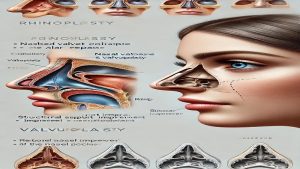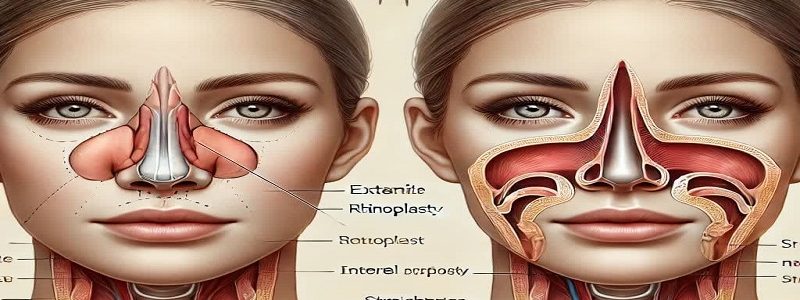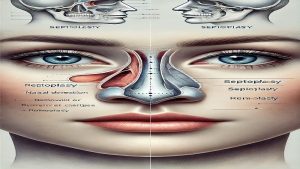Modify the form of appearance and repair of old or new injuries
Introduction
ž▒█ī┘å┘ł┘Š┘䞦ž│ž¬█ī (Rhinoplasty) One of the most common and popular cosmetic and reconstructive surgeries is aimed at modifying the shape and function of the nose.. This surgery can be cosmetic reasons (Correction of asymmetry, shrinking or deforming the nose) Or for functional reasons (Such as resolving respiratory problems caused by nasal septum deflection or fracture injuries) be done. Nasal fracture is one of the most common facial damage that can lead to appearance, respiratory obstruction and even chronic pain.. In this article from the site of Dr. Behnam Khorrami (Isfahan nose surgeon _ Jaw surgeon of Isfahan)We fully address the rhinoplasty and its role in modifying the form of the nose and repairing old or new fractures..
Rhinoplasty
The nose consists of complex structures including bone, cartilage, soft tissue and skin. These structures are an important role in respiratory function, sound production (Sound intensification) And have the overall appearance of the face. Nasal anatomy is divided into three main sections:
Bone section: Includes nose bones that form the upper part of the nose.
The cartilage section: Includes lateral cartilage and nasal tip that are in the middle and lower nose.
Septum (ž│┘Šž¬┘ł┘ģ): The central structure of the nose consisting of cartilage and bone and plays an important role in maintaining the symmetry and openness of the airway..
Fractures of the nose
Causes of nasal fractures
Nasal fractures usually occur due to direct impact, which can be caused by the following:
Traffic accidents
Sports injuries
Falling
Conflict and conflict
Occupational damage
Symptoms of a broken nose
Swelling and bruising: Especially around the eyes (appearance “Panda eye”)
nose bleeding
Pain and sensitivity to touch
Change the shape of the nose: Bend, indentation or bump
Respiratory disorders: Due to the deflection of the nasal septum or mucosal swelling
Calling when touching the nose
The complications of untreated fracture
The following problems may occur if left untreated nasal fracture time:
Septum deviation: That leads to respiratory disorders.
Adhesion: Chronic nasal cramps.
Permanent deformity: That changes the appearance of the nose permanently.
Damage to the cartilage: That can disrupt the function and structure of the nose.
ž▒█ī┘å┘ł┘Š┘䞦ž│ž¬█ī (Cosmetic surgery and restorative nose)
types ž▒█ī┘å┘ł┘Š┘䞦ž│ž¬█ī
Beauty rhinoplasty (Cosmetic Rhinoplasty):
Correction of hump nose
Change the tip of the nose
Shrinking or narrowing the nose blades
Improving nose symmetry
Before we go into this care, we must say that dizziness and nausea after surgery is completely normal and this issue will gradually disappear with the disappearance of the effects of anesthesia. (Reconstructive Rhinoplasty):
Correction of fracture injuries
The regeneration of cartilage and bone
Eliminate respiratory obstacles
Repair of septum deviation (ž│┘Šž¬┘ł┘Š┘䞦ž│ž¬█ī)
Secondary rhinoplasty (Revision Rhinoplasty):
Correction of problems caused by previous surgeries
Improve respiratory function and appearance of beauty
Rhinoplasty surgery
1. Open rhinoplasty (Open Rhinoplasty):
In this way, a small cut in the clomella area (Middle part between nostrils) is created. This technique gives the surgeon accurate access to the internal structures of the nose.
Advantages:
Precise control over the structure of the nose
Suitable for correcting complex changes
Disadvantages:
More inflation
Small Oscar Remaining
2. Closed rhinoplasty (Closed Rhinoplasty):
In this way, all cuts are done in the nostrils.
Advantages:
Non -observing external scarring
Reduced recovery time
Disadvantages:
Limit access to internal nasal structures
correction Fractures of the nose With rhinoplasty
Restoration of new fractures
In new fractures (Less than 2 weeks), Usually manual modification (Closed Reduction) It is possible.
If manual correction is not possible, open rhinoplasty is performed.
Repair of old fractures
In old fractures, repair is usually using cartilage grafts (Of the nose blade, ear or ribs) Done.
Reconstruction of nasal septums and side walls is done with advanced rhinoplasty techniques.
Recovery period after rhinoplasty and nasal fracture repair
Primary care
Use cold compresses for 4 hours to reduce swelling
Inaccation of heavy physical activity for 2 weeks
Sleeping with a head above the body surface to reduce inflammation
Avoid hitting the nose until the full boiling of the bone
recovery time
Primary inflation: 1 to 2 weeks
Completely reducing inflation: 2 months to 5 years
The final appearance of the nose: After 6 months
Possible complications of rhinoplasty
Bleeding
The infection
Asymmetry
Breathing problems
Staircase
Need secondary surgery
Rhinoplasty results
The successful results of rhinoplasty depend on the following factors:
Experience and skill of the surgeon
Quality of nasal tissues
Postoperative care
Patient realism about expectations of the outcome of the action

Conclusion
Rhinoplasty and repair of nasal fractures not only help improve appearance and fitness, but also improve the respiratory function by modifying structural problems.. Restoration of new and old nose fractures requires careful evaluation, proper planning and implementation of advanced surgical techniques.
Useful links:
Isfahan nose surgeon _ Jaw surgeon of Isfahan
Dr. Behnam Khorrami's page in the clinic 24 | Maxillofacial surgeon in Isfahan clinic 24 | Nose surgeon in Isfahan clinic 24
Dr. Behnam Khorrami, nose surgeon in Isfahan at Dr. Af | Maxillofacial surgeon in Isfahan at Dr. Af | Isfahan nose surgeon at Dr. Af


















